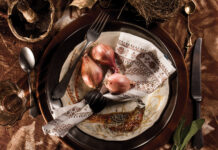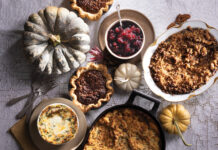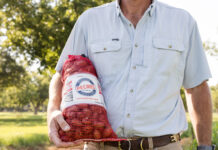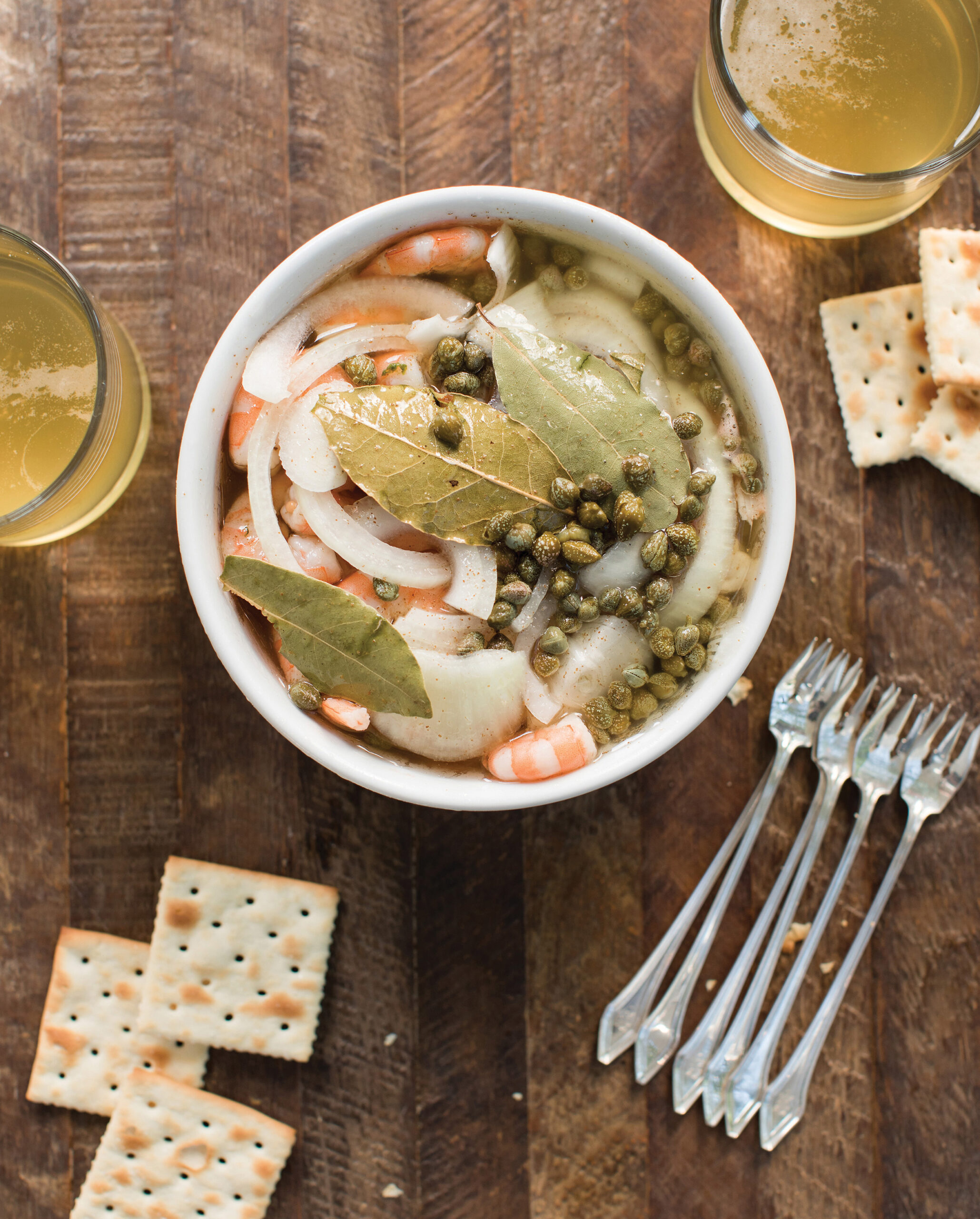

A sage of the land cultivates his wisdom as he does his soil. He’s learned over time the feel of healthy earth in his palm and the viability of a sapling by the give of its stem. He lends himself the grace to fail and the motivation to grow in a cycle of disappointment and revelation, understanding his command over his parcel of nature by the taste of his fruit. He is eternally a student of his terrain and the agrarian scholars who came before him, carrying with him empirical knowledge into his own journey of discovery. Lawrence Gardner is one these masters of earth and verdure, and his berry farm is a testament to his stewardship of his land.
Despite what his last name might suggest, Gardner hasn’t always cultivated plants. He left his career when his wife, Marian Lou, began facing health challenges, which gave him time to see the potential in his land. “I was in hospital administration before I retired,” he says. “My wife and I bought our property in 1997. It was wooded and had underbrush, and it took about three years to have it cleared completely. We decided to put the land to good use and turned it into a hay farm, but the prices of fuel and fertilizer — costs got crazy out of sight. So, one day, I visited a blueberry farm, and I was so impressed by their small operation. That’s about when we switched over to berry farming.”

Gardner’s decision to turn a patch of land into a berry farm wasn’t as simple as planting seeds. Helping it thrive was another challenge entirely. “We had to figure some things out when we decided to do this. I knew that I wanted to do blueberries and blackberries, but blackberries take about six years to grow, and even though blueberries only take about two years, you have to go through multiple seasons until you get the right flavor,” he says. He eventually mastered the art of cultivation, but getting the fruit off his bushes was another hurdle. “When we started producing those first couple of years, we couldn’t get the number of people we needed to come out and pick,” he says. Gardner reassured his wife when she worried about waste. To him, fallen fruit was just fertilizer for the seasons to come. “You’re going to see one day that there’s going to be more pickers than berries.”
Word eventually spread about Gardner’s berries. Thanks to farmers markets and word-of-mouth testimonials, demand steadily grew for his products. “You open when you have product, but that doesn’t mean you have a lot of it. We have about a six to eight-week growing season, so you’re going to have some early product, and more will grow as the season goes on,” he says. They opened for the season as usual in 2020, expecting a steady flow of customers on par with previous years. An overwhelming turnout proved otherwise. “Before you know it, cars were on both sides of our 800-foot-long driveway all the way to the street. We ran out of buckets, so I started cutting the tops off old milk jugs for people to use. We started to run out at about 11:00, and by 11:30 I had to put a tractor across the driveway with a sign that said, ‘Closed due to overpicking.’ The rest of that season, we could only open by appointment only. But that was the day I proved to my wife that we would have more pickers than berries.”
Gardner’s customers care about more than just the flavor of their fruit. They want to know what went into growing them — and what didn’t. “Everything I grow is organic. When you sit at a farmer’s market, you want to impress upon people the quality of the product you’re selling,” he says. “One of the first things that people ask me is what kind of pesticides I use. I tell them I don’t use any. It’s the more responsible thing to do. You can’t go spray a hard pesticide on a growing fruit and then go out there and sell it to somebody. You just have to be honest with people and tell them what you use to produce your product.”


Without pesticides, farming becomes a balancing act of science and strategy. Gardner fine-tunes his soil with additives, monitors pH levels and experiments with natural ways to deter pests. Deer and ants are challenging adversaries, but one of the farm’s biggest threats is the spotted wing drosophila, a tiny fruit fly that can ruin a growing season. Through careful study, he’s learned how to fight back against environmental forces without compromising the integrity of his crops.
Nature presents greater challenges than pests and soil chemistry. Blackberry plants have shallow roots that make them particularly vulnerable to heavy rain and unrelenting winds. When Hurricane Sally tore through the Southeast in 2020, Gardner’s crops stood little chance of survival. What the storm didn’t drown, it ripped from the ground. “Those blackberry vines that were tied to wires were whipped and beaten and broken,” he recalls. “It’s hard to imagine all that damage — I called it carnage. Anything and everything that could fly was flown that night. There was no assistance from any farming administrations or insurance because specialty farms aren’t covered. Putting it back together took over a year.”
Undeterred by the devastation, Gardner rebuilt and expanded. He’s added vegetables to his crops, experimenting with indoor germination to give seedlings a strong start. His garage has become something of a laboratory where he experiments with germination techniques and fine tunes his soil additive cocktails. It’s a grower’s playground where art and science converge.
Gardner’s organic science goes hand-in-hand with sustainability and growing quality products. “It’s not that I’m just lucky that I planted varieties of plants that miraculously grew into this fabulous-tasting berry,” he says. “I know the soil chemistry and get the soil tested, which tells me what micronutrients need to be added. And I try to do it as sustainably as possible.” To keep his soil healthy, Gardner turns to natural amendments like coconut coir — a more-eco-friendly alternative to peat moss — along with worm castings and byproducts of the pork industry to introduce beneficial bacteria to the ground. “A lot of companies are going to produce fertilizers through a chemistry process at a plant that looks like a refinery for gasoline. Taking these micronutrients and minerals and putting them into the soil sends it directly into the root systems of your plants and makes them flourish.”

And his crops do flourish. Gardner’s careful cultivation of his farm produces bountiful crops of several blueberry varieties, including ones that allow small children to harvest fruit at their own level. “This space appeals to mothers with small children,” he says, referring to the high tunnel greenhouse on his property. “The ones in here are a shorter variety of plant. Instead of moms taking their kids out in the field and having to try to watch two or three of them going in all different directions, they can come in here, and the kids can pick at their elevation. Some of our best group gatherings have been daycares and Sunday school classes that come after church. Sometimes they’ll even bring picnics.”
When the harvest season winds down in the fall, preserving summer fruits and vegetables is a simple way for families to enjoy fresh produce during the colder months. “There are different ways to preserve fruits and vegetables. People do compotes and canning. Freezing is a good way to keep them — probably the most predominant method people use around here,” Gardner says. “But one factor that affects the quality of a frozen fruit or vegetable overwhelmingly is when water comes in contact with the fruit or vegetable. If it has moisture on it when it goes in the freezer, the skin will fracture, and it’ll crack when you thaw it out. Then it’ll be mushy. Don’t wash them before they go in the freezer, and bring them to room temperature first. They hold onto heat when you pick them in the field and will create moisture if they go in too hot. Completely cool them down first and get all the air out of the bag. That’s how you end up with a better product.”
Gardner’s farm thrives due to his own efforts, but it also benefits from sharing resources with others in his agrarian community. “I have a gentleman in the Loxley community who’s a beekeeper who needed a place for a bunch of beehives. Well, for me, having more bees is good because they keep everything pollinated really well. And he gives me a little honey once in a while,” he says. Gardner has also managed to trade blueberries for pine straw because of his friendship with another farmer and has offered guidance to others in the berry business. “A few years ago, one of the other blueberry growers in the area was selling his product for less than anywhere else. One day, I went to him and asked, ‘Why would you cut your own throat selling for less when you do so much more?’ I told him that sometimes you have to impress upon people that they’re getting a price worthwhile for your labor and investment. People want to pay for quality.”
Buying local isn’t just about taste — it’s about supporting a farmer that cares about the quality of the food you eat. “When you go to a major supermarket, read the label on the blueberries. They could be a product from anywhere,” he says. “In some other countries, there aren’t always as many regulations, and there’s so much that’s unknown about the product. It’s important for people to take a good hard look at where their fruits and vegetables are coming from and what methodologies are being used. Find the local farmers who are doing things the right way and utilize and support them. It’s worth it to go out to the country and get a good product, because you’re not just getting the value of great taste. You’re getting the value of health.”
Gardner’s Berry Farm // 21909 County Rd 68 N, Robertsdale, AL 36567 gardnersberryfarm.com
Recipes for Maximizing Your Summer Produce

TEMPER JARS
While quick-pickling does not require sterilized jars like true canning does, you should temper them so they don’t crack when boiling water is added. Choose any heat-proof container with a tight-fitting lid. Rinse under hot running water until heated through, 1 to 2 minutes. Shake dry.

Mixed Berry Compote
Buy too many berries? This compote makes a spectacular breakfast when served over plain yogurt with a sprinkling of granola, and a decadent dessert when spooned over pound cake and topped with a dollop of creme fraiche.
MAKES 1 PINT
2 cups fresh berries (quartered strawberries, blueberries, and blackberries)
1/4 cup brown sugar
1 teaspoon lemon zest
1 tablespoon lemon juice
1 pinch sea salt
1. Combine all ingredients in a heavy-bottomed saucepan. Bring to a boil over medium-high heat, and then reduce to a simmer, cooking until the mixture thickens, about 45 minutes, stirring occasionally. The compote will continue to thicken as it cools.
2. Remove from heat and transfer to tempered jars. Allow to cool to room temperature then cover with a lid and store in the refrigerator for up to 10 days.
Cherry Tomatoes Preserved in Olive Oil

These tomatoes make a ready-made sauce for plain pasta, or become a fabulous appetizer with goat cheese on a crostini, or toss some with your scrambled eggs!
MAKES 2 PINTS
2 pints cherry tomatoes
3/4 cup of olive oil, divided
3 sprigs of fresh thyme
6-8 basil leaves, torn
3 cloves of garlic, smashed
1/2 teaspoon salt
Freshly cracked black pepper, to taste
1. Preheat the oven to 225 degrees. Rinse and dry the tomatoes, then spread onto a rimmed baking sheet. Add the seasonings, then drizzle with 3 tablespoons olive oil and toss well, making sure everything is coated.
2. Roast for 2 1/2 hours, stirring occasionally, until tomatoes are blistered. Remove garlic and herbs and discard.
3. Transfer the tomatoes to tempered jars. Cover completely with olive oil. Allow to cool to room temperature then cover with lid and store in the refrigerator for up to 4 weeks.
Refrigerator Corn Relish
This tangy-sweet relish is the perfect condiment for tacos or black bean soup, and is an excellent dip with tortilla chips!
MAKES 2 PINTS
3 ears corn
2/3 cup apple cider vinegar
1/3 cup water
1/3 cup raw sugar
1 tablespoon mustard seeds
2 teaspoons cumin seeds
1/2 teaspoon celery seeds
1/2 teaspoon kosher salt
1/2 cup finely diced red onion
2 garlic cloves, sliced
1 small red bell pepper, finely diced
1 small green bell pepper, finely diced
1 jalapeno chile, minced
1. Bring a large pot of water to a boil and add corn. Boil 3 minutes and transfer to a bowl of ice water. When corn is cool enough to handle, pat dry and cut kernels from cobs. Set aside.
2. In a medium, heavy-bottomed pot combine vinegar, sugar, water, mustard seeds, cumin seeds, celery seeds and salt and bring to a boil. Stir until sugar has dissolved, then add onion. Reduce heat and simmer 5 minutes. Add peppers, garlic and chile and simmer for another 5 minutes. Stir in corn kernels and simmer 1 minute.
3. Remove from heat and transfer to tempered jars. Allow to cool to room temperature then cover with a lid and store in the refrigerator for up to 2 months.
Refrigerator Pickled Vegetables
Quick pickling requires a 1:1 ratio of vinegar and water. The seasonings, salt and sugar, however, can vary according to your taste. Try citrus zest, spicy peppers, fennel seeds — whatever sounds good to you!
MAKES 1 QUART
5 cloves garlic, peeled
1 1/2 cups white vinegar
2 tablespoons kosher salt
3 tablespoons raw sugar
Several sprigs of fresh dill
1/2 teaspoon celery seed
1/2 teaspoon coriander seed
1/2 teaspoon mustard seed
1/4 teaspoon black peppercorns
1 jalapeno pepper
Vegetables of your choice to fill a 1-quart jar
1. In a medium saucepan, bring 1 1/2 cups water to a boil. Reduce the heat so the water simmers and add the garlic. Cook for 5 minutes. Add the vinegar, salt and sugar, return to a rolling boil, and stir until the salt and sugar dissolve. Remove from heat.
2. Place dill, seeds and peppercorns in a tempered 1-quart jar. Remove the garlic from the brine and add to the jar. Then tightly pack the jars full of vegetables and jalapeno.
3. Bring the brine back to a boil, then pour it over the vegetables to cover completely. Let cool, then cover and refrigerate up to 3 months. Pickles are ready to eat in just a few hours but are best after a couple of days.






